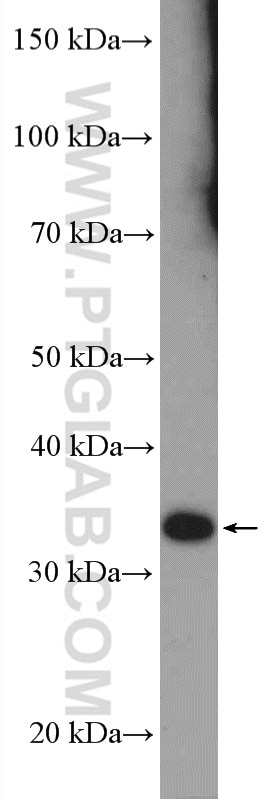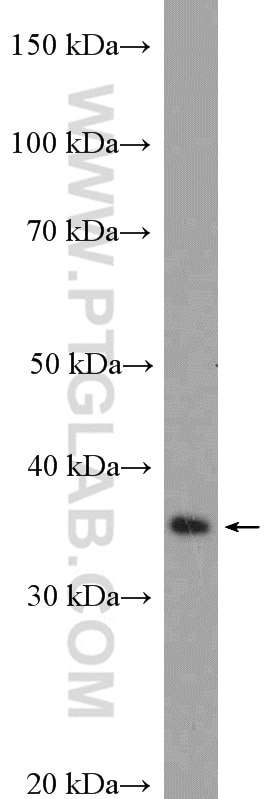Anticorps Polyclonal de lapin anti-RSPH9
RSPH9 Polyclonal Antibody for WB, ELISA
Hôte / Isotype
Lapin / IgG
Réactivité testée
Humain, rat, souris
Applications
WB, IF, ELISA
Conjugaison
Non conjugué
N° de cat : 23253-1-AP
Synonymes
Galerie de données de validation
Applications testées
| Résultats positifs en WB | tissu testiculaire de souris, cellules NIH/3T3, tissu testiculaire de rat |
Dilution recommandée
| Application | Dilution |
|---|---|
| Western Blot (WB) | WB : 1:500-1:1000 |
| It is recommended that this reagent should be titrated in each testing system to obtain optimal results. | |
| Sample-dependent, check data in validation data gallery | |
Applications publiées
| WB | See 4 publications below |
| IF | See 3 publications below |
Informations sur le produit
23253-1-AP cible RSPH9 dans les applications de WB, IF, ELISA et montre une réactivité avec des échantillons Humain, rat, souris
| Réactivité | Humain, rat, souris |
| Réactivité citée | Humain, souris |
| Hôte / Isotype | Lapin / IgG |
| Clonalité | Polyclonal |
| Type | Anticorps |
| Immunogène | RSPH9 Protéine recombinante Ag19745 |
| Nom complet | radial spoke head 9 homolog (Chlamydomonas) |
| Masse moléculaire calculée | 276 aa, 31 kDa |
| Poids moléculaire observé | 31-35 kDa |
| Numéro d’acquisition GenBank | BC029519 |
| Symbole du gène | RSPH9 |
| Identification du gène (NCBI) | 221421 |
| Conjugaison | Non conjugué |
| Forme | Liquide |
| Méthode de purification | Purifié par affinité contre l'antigène |
| Tampon de stockage | PBS avec azoture de sodium à 0,02 % et glycérol à 50 % pH 7,3 |
| Conditions de stockage | Stocker à -20°C. Stable pendant un an après l'expédition. L'aliquotage n'est pas nécessaire pour le stockage à -20oC Les 20ul contiennent 0,1% de BSA. |
Protocole
| Product Specific Protocols | |
|---|---|
| WB protocol for RSPH9 antibody 23253-1-AP | Download protocol |
| Standard Protocols | |
|---|---|
| Click here to view our Standard Protocols |
Publications
| Species | Application | Title |
|---|---|---|
Hum Mol Genet Loss of DRC1 function leads to multiple morphological abnormalities of the sperm flagella and male infertility in human and mouse. | ||
Eur J Hum Genet Bi-allelic variants in human TCTE1/DRC5 cause asthenospermia and male infertility. | ||
Cell Rep Differential requirements of IQUB for the assembly of radial spoke 1 and the motility of mouse cilia and flagella | ||
EBioMedicine CFAP70 is a solid and valuable target for the genetic diagnosis of oligo-astheno-teratozoospermia in infertile men | ||
Cell Structures of sperm flagellar doublet microtubules expand the genetic spectrum of male infertility | ||
Elife LRRC23 truncation impairs radial spoke 3 head assembly and sperm motility underlying male infertility |





